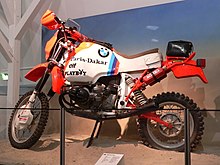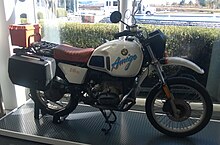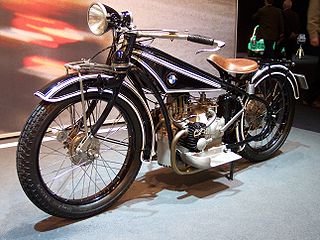
BMW's motorcycle history began in 1921 when the company commenced manufacturing engines for other companies. BMW's own motorcycles—sold under the BMW Motorrad brand—began in 1923 with the BMW R 32, which was powered by a flat-twin engine. Production of motorcycles with flat-twin engines continues to this day, however BMW has also produced many models with other types of engines.

The BMW GS series of one purpose off-road/on-road BMW motorcycles have been produced from 1980, when the R80G/S was launched, to the present day. The GS refers to either Gelände/Straße or Gelände Sport. GS motorcycles can be distinguished from other BMW models by their longer travel suspension, an upright riding position, and larger front wheels – typically 19 to 21 inch. In May 2009, the 500,000th GS was produced, an R1200GS model.

The BMW 247 engine is an air-cooled flat-twin motorcycle engine with two valves per cylinder, also known as the "airhead" boxer. It was used by BMW in its motorcycles from 1969 to 1995.
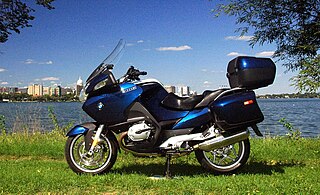
The BMW R1200RT is a touring or sport touring motorcycle that was manufactured from 2005 to 2019 by BMW Motorrad to replace the R1150RT model. It features a 1,170 cc (71 cu in) flat-twin engine with a six-speed gearbox and shaft drive.

Douglas was a British motorcycle manufacturer from 1907 to 1957 based in Kingswood, Bristol, owned by the Douglas family, and especially known for its horizontally opposed twin cylinder engined bikes and as manufacturers of speedway machines. The company also built a range of cars between 1913 and 1922.
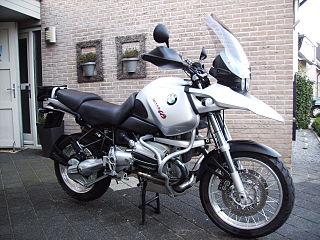
The BMW R1150GS and R1150GS Adventure are motorcycles that were manufactured by BMW Motorrad from 1999 through 2004. There was a limited run of 2005-06 model year R1150GSA models as well. The R1150GS models are part of the BMW GS family of dual-sport or adventure motorcycles that have been produced from 1981 to the present date. The bikes have a 1,130 cc horizontally opposed flat-twin engine and shaft drive.

The BMW R1100GS is a dual-sport motorcycle that was launched in 1993, and manufactured from 1994 to 1999 by BMW Motorrad in Berlin, Germany. The bike has a 1,085 cc (66.2 cu in) flat-twin (boxer) engine, first seen in the R1100RS which was launched the year before in 1992, and was the first member of the GS family to use an air- and oil-cooled engine rather than the earlier air-cooled airhead engines which had been used on BMW motorcycles since the R32 in 1923.
BMW Motorrad is the motorcycle brand and division of German automotive manufacturer, BMW. It has produced motorcycles since 1923, and achieved record sales for the fifth year in succession in 2015. With a total of 136,963 vehicles sold in 2015, BMW registered a growth of 10.9% in sales in comparison with 2014. In May 2011, the 2,000,000th motorcycle produced by BMW Motorrad was an R1200GS.

The BMW F series is a family of parallel-twin engine dual-sport motorcycles manufactured in Berlin, Germany by BMW Motorrad. Launched in 2008, the range comprises the F650GS, F700GS, F800GS, and F800GSA. In 2012, the F700GS replaced the discontinued F650GS, and in 2013, the F800GSA was introduced with a 24-litre fuel tank and a larger front fairing and screen. The F800GT and F800S both have belt drive.

The BMW F650 is a family of motorcycles developed by BMW Motorrad beginning in 1993. Models included the F650St Strada and from 1994, the F650 which, due to some subtle differences, was considered to be a more dual/multi purpose motorcycle with some off-road capability. The 1993 - 2000 F650 was the first single-cylinder motorcycle from BMW since the 1960–1966 R27, and the first chain driven motorcycles from BMW.

The BMW R65 is a light touring motorcycle introduced by BMW in 1978 to add a mid-size motorcycle to its product line. The original R65, contrary to the views of some commentators, has the same sized frame as the larger R series motorcycles. The R65 does however have a shorter swingarm than its siblings and therefore a shorter bolt-on rear sub-frame; this, along with the shorter front forks and 18" front wheel, gives the illusion that the R65 frame is smaller. The initial model R65 was manufactured until 1984. In 1985 the R65’s engine was put into the same frame and suspension as the R80 which featured a single rear shock absorber (mono-shock). Additionally, between 1981 and 1984, the R65LS was manufactured. This R65 variant has a small triangular fairing that was designed by Hans Muth.

The BMW R1100S is a sports motorcycle that was manufactured by BMW Motorrad between 1998 and 2005. Introduced some 25 years after the R90S, the company's first sports bike, the R1100S was the first BMW bike having clip-on handlebars, rearset footrests and a removable cowl to cover the pillion seat. Producing nearly 100 hp, it has been described as a "sporty sports-tourer".
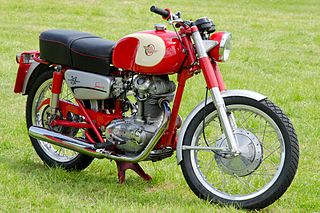
The Ducati Sebring is a 340 cc (21 cu in) single cylinder bevel drive SOHC motorcycle produced by the Italian manufacturer Ducati from 1965 to 1968. At the time of its introduction it was the largest capacity Ducati machine. Production of the original model ended in 1967 when the 'wide case' Mark 3 was introduced, although just over 200 Sebrings were made in 1968 with the 'wide case' engine. Total production was around 3,500 machines.

The Ducati 350 Mark 3 is a 340 cc (21 cu in) single cylinder bevel drive SOHC motorcycle produced by the Italian manufacturer Ducati from 1968 to 1974. It was one of the first 'wide case' Ducati singles produced. A higher performance version, the Ducati 350 Mark 3D, which used desmodromic valves was also available.

The Ducati 250 Mark 3 is a 249 cc (15.2 cu in) single cylinder bevel drive SOHC motorcycle produced by the Italian manufacturer Ducati from 1967 to 1974. Initially produced using the 'narrow case' engine, the newly introduced 'wide case' engine was used from 1968. A higher performance version, the Ducati 250 Mark 3D, which used desmodromic valves was also available.
The Ducati Monza is a 249 cc (15.2 cu in) single cylinder bevel drive SOHC motorcycle produced by the Italian manufacturer Ducati from 1961 to 1968. It was the touring version of Ducati's first 250 cc road bike. Reviews of the Monza praised its speed, road holding, engine smoothness and brakes.
The Ducati Diana, known as the Ducati Daytona in the UK, is a 249 cc (15.2 cu in) single cylinder bevel drive SOHC motorcycle produced by the Italian manufacturer Ducati from 1961 to 1964. It was the sports version of Ducati's first 250 cc road bike. It was replaced in 1962 by the higher performance Ducati Diana Mark 3 in the US and by the Ducati Mach 1 in Europe in September 1964.
The Ducati 250 GT, also known as the Ducati Daytona GT in the UK, is a 249 cc (15.2 cu in) single cylinder bevel drive SOHC motorcycle produced by the Italian manufacturer Ducati from 1964 to 1966. At the time of its launch it was the least powerful of Ducati's range of 250 cc machines.

The Ducati 450 R/T (road/trail) is a 436 cc (26.6 cu in) single cylinder bevel drive desmodromic SOHC motorcycle produced by the Italian manufacturer Ducati from 1971 to 1974. Initially produced at the request of the American importers Berliner Motor Corporation as a pure motocross machine exclusively for the American Market, only a few hundred machines were made of this type. It is the only motocross bike to use desmodromic valves. An optional street equipment kit was available. From 1972 it was produced for the European Market as a street legal on/off road machine, which was sometimes known as the 450 T/S.
The Ducati Road 350 is a 340 cc (21 cu in) single cylinder bevel drive SOHC motorcycle produced by the Spanish manufacturer MotoTrans, who were licensed by Ducati to produce motorcycles under the Ducati brand name and was produced from 1973 to 1976. The model was intended to be for the Spanish domestic market although it was also exported to the US in 1973.

